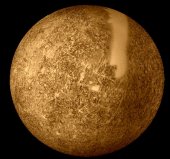
Worksheets and No Prep Teaching Resources
Reading Comprehension Worksheets
Solar System

Solar System
 Worksheets and No Prep Teaching Resources Reading Comprehension Worksheets Solar System |
 Solar System |
| edHelper's suggested reading level: | grades 3 to 5 | |
| Flesch-Kincaid grade level: | 4.37 |
|
Mercury
By Cindy Grigg |

|
 1 Mercury is the closest planet to the sun. It has almost no atmosphere. This means there is no air. Because there's no air, there is no weather. It is a small planet. Mercury is about one-third the size of Earth. If Earth were the size of a baseball, Mercury would be the size of a golf ball. Because it is so small, gravity is much less on Mercury than on Earth. If you weighed 100 pounds on Earth, you would only weigh 38 pounds on Mercury.
1 Mercury is the closest planet to the sun. It has almost no atmosphere. This means there is no air. Because there's no air, there is no weather. It is a small planet. Mercury is about one-third the size of Earth. If Earth were the size of a baseball, Mercury would be the size of a golf ball. Because it is so small, gravity is much less on Mercury than on Earth. If you weighed 100 pounds on Earth, you would only weigh 38 pounds on Mercury. |
Create Weekly Reading Books
Prepare for an entire week at once! |
| Leave your feedback on Mercury (use this link if you found an error in the story) |
 |
Solar System
|
 |
Science
|